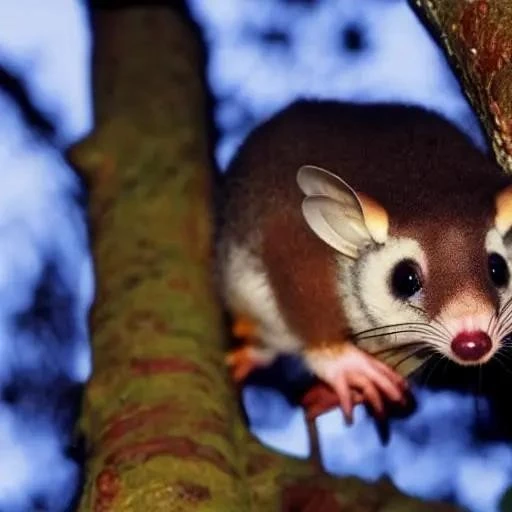Beneath the shimmering cloak of the Australian night, a secret world unfurls, inhabited by creatures often heard rustling in the eaves but rarely truly understood. For generations, the enigmatic possum has captivated our imaginations, a nocturnal enigma navigating the urban jungle and ancient bushland alike. But how far do possums truly travel at night in Australia, these silent, furry architects of the dark? The answer, surprisingly complex and profoundly illuminating, is reshaping our understanding of urban ecology and wildlife conservation, promising a future where humans and marsupials can thrive side-by-side.
Far from being mere backyard fixtures, these arboreal acrobats embark on surprisingly extensive nocturnal journeys, driven by an innate quest for sustenance, shelter, and mates. The distances covered are not uniform; they are meticulously orchestrated ballets influenced by species, habitat, and the ever-present pressures of survival in a rapidly changing environment. By integrating insights from cutting-edge research and citizen science initiatives, experts are now meticulously mapping these hidden pathways, painting a vivid picture of the sheer resilience and adaptability of Australia’s beloved marsupials.
Key Australian Possum Species: Nocturnal Habits & Movement
| Characteristic | Common Brushtail Possum | Common Ringtail Possum |
|---|---|---|
| Typical Habitat | Urban gardens, woodlands, forests, suburban areas | Dense foliage, bushy gardens, forests, coastal areas |
| Diet | Omnivorous: leaves, fruits, flowers, insects, eggs | Herbivorous: leaves (especially eucalyptus), flowers, fruits |
| Nocturnal Activity | Highly active, solitary | Active, often seen in family groups (“dreys”) |
| Average Home Range | 1-3 hectares (can be smaller in urban areas) | 0.5-1.5 hectares |
| Factors Influencing Travel | Food availability, mating, territory defense, den sites | Food availability, den sites (dreys), predator avoidance |
| Conservation Status | Least Concern (but faces urban threats) | Least Concern (but faces urban threats) |
| Official Reference | Australian Museum ― Brushtail Possum | Australian Museum, Ringtail Possum |
While the iconic Common Brushtail Possum (Trichosurus vulpecula) might be the most familiar face peering from a gum tree, its nocturnal wanderings often span a home range of one to three hectares. However, these figures are not static; they fluctuate significantly based on resource availability. In lush urban parks brimming with food and abundant den sites, a brushtail might patrol a smaller, intensely defended territory. Conversely, in sparser bushland, a brushtail could traverse greater distances, sometimes exceeding a kilometer in a single night, just to find a suitable meal or a safe hollow.
The smaller, more communal Common Ringtail Possum (Pseudocheirus peregrinus) presents a fascinating contrast. Living in family groups within intricate dreys (nests of leaves and bark), their nightly forays are typically more constrained, often within a half to one-and-a-half-hectare home range. Their movements are primarily dictated by the location of prime eucalyptus leaves, their dietary staple, and the safety of their communal dwelling. Dr. Emma Johnson, a leading marsupial ecologist at the University of Sydney, explains, “Ringtails are less individualistic explorers. Their movements are a collective effort, focusing on efficient foraging within a relatively secure patch, often returning to the same drey night after night. Understanding these nuanced species-specific behaviors is absolutely crucial for effective urban wildlife management.”
These nocturnal journeys are not random strolls; they are strategic expeditions, each possum acting as a tiny, furry cartographer, mapping its world through scent, memory, and instinct. Imagine a miniature explorer, driven by the primal call of survival, navigating a complex labyrinth of fences, power lines, and tree branches with remarkable agility. This profound understanding of possum travel patterns is increasingly informing urban planning. For instance, initiatives in Brisbane and Melbourne are now incorporating ‘possum bridges’ and vegetation corridors, facilitating safer movement across roads and fragmented habitats, proving incredibly effective in reducing road fatalities and promoting genetic diversity within populations.
The question of how far possums travel at night in Australia reveals far more than just distances; it unveils the intricate dance of life in a shared landscape. As our cities expand, understanding these cherished nocturnal neighbors becomes not just a scientific curiosity but an urgent imperative. With continued research, innovative conservation strategies, and a growing appreciation for their vital role in our ecosystems, we can confidently forge a future where Australia’s possums continue their nightly wanderings, thriving alongside us, enriching our environment with their enduring presence. The path forward is illuminated by knowledge, guiding us towards a more harmonious coexistence, one carefully studied possum journey at a time.

